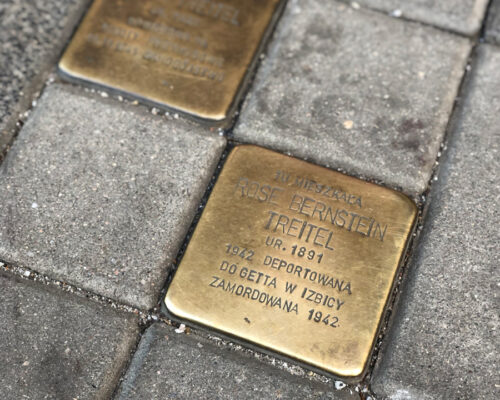In recent years, we can see more and more commemorative plaques in Wroclaw, which not only emphasize the significant presence of Jews in the city, but also remind of their tragic history. Although the historical policy of the city and the initiatives of residents and officials took the right direction, not all important places have been commemorated yet.
Numerous small commemorative plaques in the city space inform about important institutions or people associated with a particular place. These are often biographies of people who were known not only in Wroclaw (including Max Born, Willy Cohn, Clara Immerwahr-Haber), or stories about outstanding projects or institutions (including the White Stork Synagogue, the Sachs Palace, Fränkel Foundation).
Victims of Nazism
In the courtyard of the White Stork Synagogue, there is a plaque commemorating the victims of Nazism. It was on the places which serves as a collection point, from which Jews were deported to transit ghettos and extermination camps. The inscription on the board in three languages – Polish, German and Hebrew – informs about the deportations that took place in the period 1941–1944. At Łąkowa Street, there is a monument commemorating the victims of Kristallnacht. This is the place where the New Synagogue was located, which the Nazis completely destroyed during the pogrom. The Memorial to the Victims of the Kristallnacht was created on the sixtieth anniversary of the November events. It comprises the inscriptions in three languages that recall the words of Psalm 74 and inform about the extermination of Wroclaw Jews. The monument also naturally commemorates the desecrated New Synagogue. The initiator of the creation of both plaques was the Jewish community in Wroclaw, which, with the support of German government institutions, made a symbolic act of restoring the memory of the murdered Jews.
Stolpersteine
The Stolpersteine is an interesting initiative – these are small memorial stones embedded in the sidewalks in front of houses and tenement houses where the victims of Nazism lived before the war. They inform about who lived in a given place and recall the date and place of death. The originator of the brass memorial stones is the German artist Gunter Demnig. His initiative caught on in many European countries, and today, also in Poland, the stones tell Jewish stories in, for example in Oświęcim or Zamość. New Stolpersteines appear regularly in Wroclaw, they can be seen, for example, at Jedności Narodowej, Świdnicka and Zielińskiego streets. The first memorial stone in Poland was the one at Nowowiejska Street, dedicated to Edyta Stein, who died tragically in Auschwitz.
Cemeteries
A plaque commemorating German Jews is also located at the New Jewish Cemetery at Lotnicza Street. It reminds of people who died during the war and although they were buried in the cemetery, they do not have their own tombstones. There are also plaques on the walls of the cemetery commemorating Polish Jews, who were victims of the Holocaust.
There is also the Monument of Common Remembrance in the Grabiszyński Park, which symbolically restores the memory of all the inhabitants of the city, whose tombstones have been annihilated. The ceremonial unveiling of the monument was attended, among others, by Rabbi Icchak Rappaport. The matzevot of Charlotte Bandmann and Wolff Samelsohn were built into the wall of the monument.
Ghetto Heroes Square
The present Ghetto Heroes Square was the center of the Jewish quarter for many decades. Today, however, there is a monument commemorating the Heroes of the Warsaw Ghetto, which was unveiled on the 20th anniversary of the outbreak of the Uprising, on 19 April 1963, on the initiative of the Jewish Social and Cultural Society. For years, this place has been an important meeting point, where ceremonial speeches and prayers commemorating the Warsaw Ghetto Uprising were held.
Solny Square
In the heart of Wroclaw there is a place commemorating the medieval pogrom of Wroclaw Jews. The so-called Little Spire reminds us of it in Solny Square. In the mid-15th century, Jews were gathered there and burned at the stake; forty-one people died then. The pogrom was the consequence of the unfair accusations of a monk, Jan Capistran, who previously delivered sermons slandering the Jewish inhabitants of Wroclaw, accusing them of acting to the detriment of Christians. Jews who survived the pogrom, were expelled from the city, and the children were forcibly baptized.

